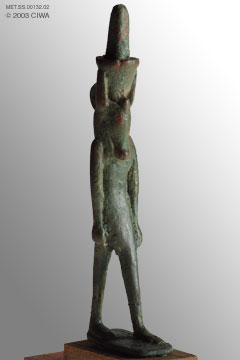Bronze Nefertem pendant amulet, Dyn. 25

Links to other views:⇒ Larger Viewif scripting is off, click the ⇒ instead. Links to others from Dynasty 25 and ContemporariesAmulet of Duamutef, Dyn. 25Amulet of Imsety, Dyn. 25 Bronze Imhotep seated, Dyn. 25 (?) Bronze of a queen nursing, Dyn. 25 Bronze of King Shabaka ? as Osiris, Dyn. 25 Bronze of Ptah, Memphis, Dyn. 25 Bronze ritual pendant of Osiris, Dyn. 25 Bronze ritual pendant of Osiris, Dyn. 25 Bronze statuette of Ptah, Dyn. 25 Faience amulet of Qebhsenuef, Dyn. 25 Five Udjat eyes amulet, Dyn. 25 Horus-the-Child as Amun, 776-656 BC Horus-the-Child, Dyn. 25, 776-656 BC Mentuemhet, prince of Thebes, Dyn. 25 Osiris-Neper, god of agriculture, Dyn. 25 Queen Aqaluqa as Isis nursing, Dyn. 25 Queen as Goddess Neith seated, Dyn. 25106 Queen as Isis nursing, Dyn. 25 Scarab of Piankhi, Dyn. 25 Twenty-eight udjat eyes amulet, Dyn. 25 Udjat eye amulet-pendant, Dyn. 25 Udjat eye amulet-pendant, Dyn. 25 Links to others representing NefertemBronze of a king as Nefertem, N.K.Bronze of King Sethi I as Nefertem, Dyn. 19 Links to others of type AmuletAmulet of Duamutef, Dyn. 25Amulet of god Thoth as a Baboon, Dyn. 18 Amulet of Imsety, Dyn. 25 Amulet of Pataikos, Dyn. 26 Amulet of Ptah-Sokar, Dyn. 20-21 Amulet of Shu, Dyn. 26 Amulet-pendant of Sakhmet, Dyn. 22 Blue glass amulet, Palestine, c. 450 AD Djed pillar, amulet of powers, Dyn. 26 Faience amulet of Anubis, 525-334 BC Faience amulet of Qebhsenuef, Dyn. 25 Gilded ib, heart amulet, Dyn.18 Gilded mkrt, snake amulet, Dyn. 18 Gilded ‘tit’ (girdle of Isis) amulet, Dyn. 18 Glass jug amulet, Palestine, c. 450 AD Glass jug amulet, Palestine, c. 450 AD Glass jug amulet, Palestine, c. 450 AD Glass jug amulet, Palestine, c. 450 AD Glass jug amulet, Palestine, c. 450 AD Glass jug amulet, Palestine, c. 450 AD Horus-the-child, Meroe, 590-300 BC Large amulet of Pataikos, Dyn. 20 Large amulet of Pataikos, Dyn. 20-21 Palm leaf amulet, Dyn. 18-19 Palm leaf amulet, Dyn. 18-19 Sakhmet amulet pendant, Dyn. 18 Shells amulet-pendant, c. 4500 BC Sky Goddess Nut as a sow, 1085-760 BC Two-fingers mummy amulet, Dyn. 26 Upper Egypt crown amulet, Dyn. 26 |
This rare bronze amulet represents the god Nefertem, son of Sakhmet and member of the Memphis Triad. This amulet was hung through the suspension ring visible behind the head. Second half of Dynasty 25 (716-664 BC). Amulet Amulets are objects generally kept on the person that are believed to confer some benefit to the wearer. While turn of the century archeologist Flinders Petrie (1914) enraged that “the belief in the magic effect of inanimate objects on the course of events is one of the lower stages of the human mind in seeking for principles of natural action. . .”, he had to concede that the use of amulets, talismans, and charms is very ingrained in many cultures to the present day. Many of us use lucky pens and wear religious medals without believing literally in their powers to affect our lives. But we still use them. They help us muster the confidence we need in times of self doubt. They empower us to dare, to believe in ourselves, to heal ourselves. Egyptians may have felt the same way. They used amulets on themselves and on their dead. Egyptians also seem to have had a passion for jewelry, and amulets were a good excuse to wear more jewelry. Egyptians created an astonishing variety of amulets. The Dendera Amulets List, engraved on the thickness of a temple doorway, shows 104 different amulets for funerary use. The MacGregor Papyrus shows and names each one (Andrews 1994:7). Petrie described some 270 kinds of amulets in his 1914 monograph on the subject, and yet it was published before the excavation of many sites rich in amulets! He devised a classification system which, for all its flaws, is useful and still stands as no worse than any devised since to put order in that which defies classification: “The various ascertained meanings may be completely put in order under five great classes… (I) the amulets of Similars which are for influencing similar parts, or functions, or occurrences, for the wearer; (II) the amulets of Powers, for conferring powers and capacities, especially upon the dead; (III) the amulets of Property, which are entirely derived from the funeral offerings, and are thus peculiar to Egypt; (IV) the amulets for Protection, such as charms and curative amulets; (V) the figures of Gods, connected with the worship of the gods and their functions… Our classes then are here called amulets of Similars, or Homopoeic. The evolution of amulets follows a fairly logical path. The first amulets were natural objects such as shells, and symbolically charged body parts of animals, such as claws from birds of prey. Then, still in predynastic times, we find figurines of significant animals, such as the hippopotamus, falcon, and jackal. Through the Old Kingdom, there was a development of animal forms with increasing levels of sophistication, and by the middle of the Old Kingdom we find the abstract symbolic subjects (such as the Ankh (sign meaning “life”), the Udjat eye of Horus, the Djed pillar, and the scarab) which remain some of the most emblematic symbols of Egyptian culture. During the First Intermediate Period we find amulets representing human body parts (ear, tongue, hand, arm, phallus, leg, heart...). The Middle Kingdom expanded the whole range of objects and gave the scarab its final form. But despite this considerable repertoire, amulets representing major gods remained rare until the end of the New Kingdom, at which time they suddenly flourished, and became as a group the most prevalent type until the end of Dynastic history. (Andrews 1994) Bibliography (on Amulet)Andrews, Carol1994 Amulets of Ancient Egypt. University of Texas Press, Texas. Petrie, W.M. Flinders 1914 Amulets. Constable & Company, London, UK. |